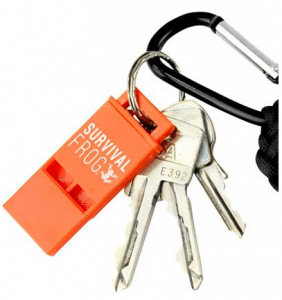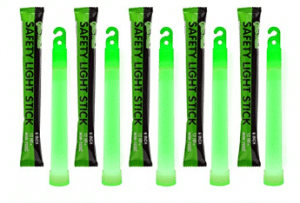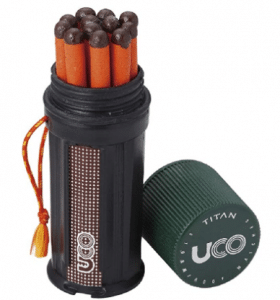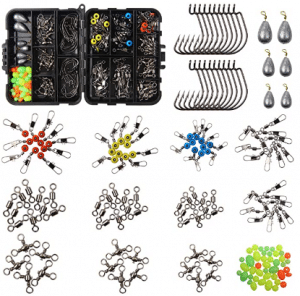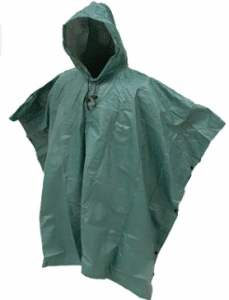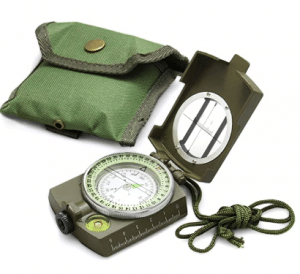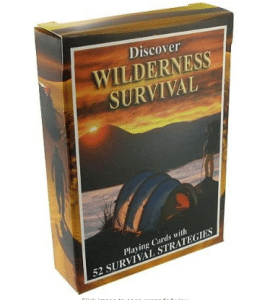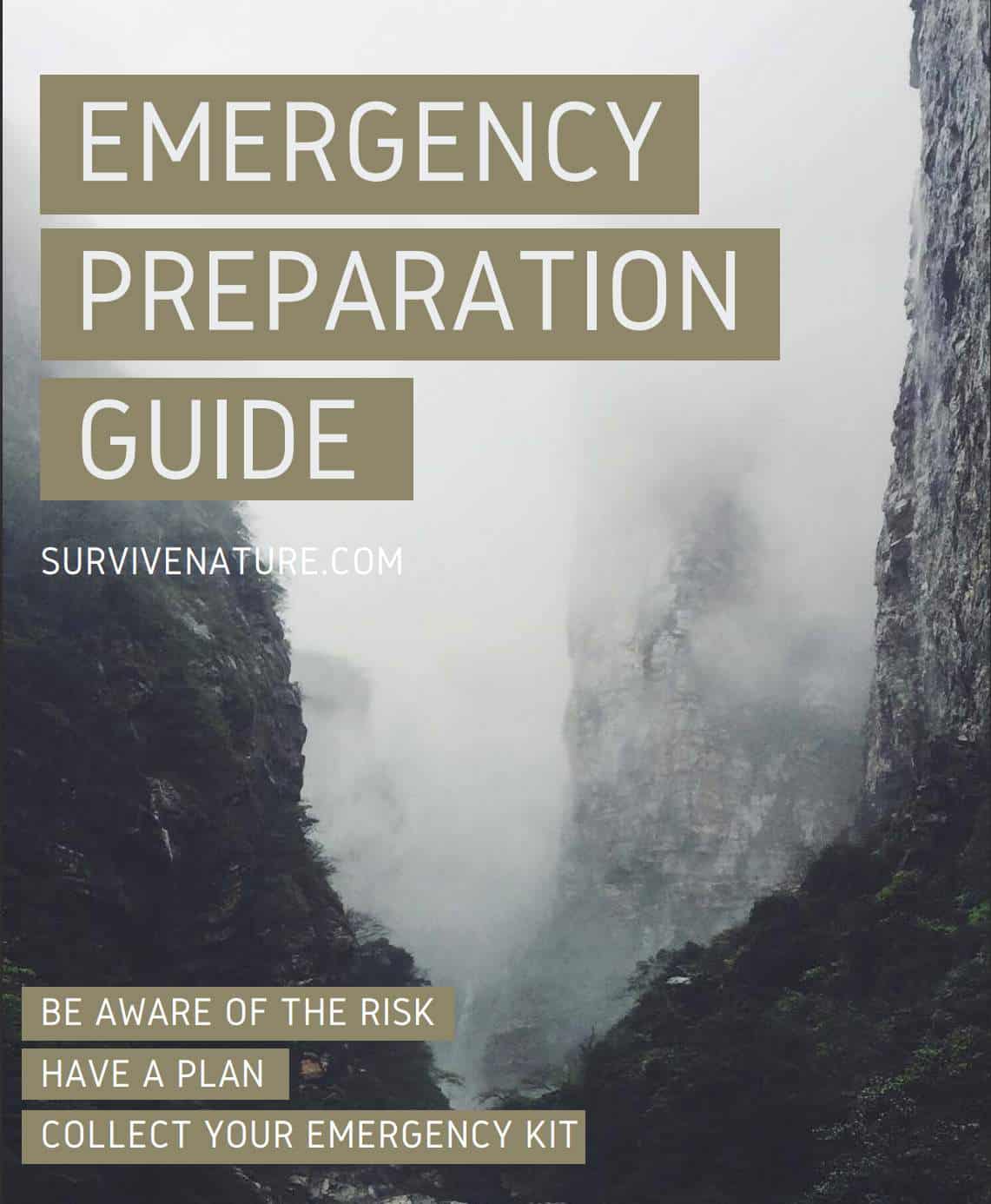All survivalists have survival kits, but they can be all different. What should a proper emergency kit have? Should it necessarily be waterproof? How to put your first-aid kit, a compass, a survival bracelet, paracord projects, rope, fishing gear, a shovel, and more in the kit and where to get such a sizable one. All this and more, in our article.
A survival kit or survival pack is a set of the most important survival equipment and emergency supplies, folded into a convenient carrying case, i.e., a bag, backpack, container, or something like that.
This is a straightforward and necessary thing. A disaster supplies kit might be the only helper when you get into an emergency situation. Usually, being prepared means staying alive when a natural disaster comes. The best survival kits are relatively light in weight and can save your life in a variety of emergency situations.
Unfortunately, natural disasters are not the only troubles survivalists face in their ways. The emergency situation might also happen if the environment is rather difficult to pass: if you are in the mountains, there are rocks and cliffs; if you are in the forest, there are roots protruding from the ground. Basic items of any emergency survival kit thus must include first aid means to help a person, say, with a broken limb.
Except for that, we all are different, and we all might have individual needs. Individual needs, or specific needs, usually include non-rescription or prescription medications, or some specific personal hygiene items.
But beware, not all survival kits are created equal.
Before buying, we advise you to compare different sets of survival kits and read our article to navigate the variety of survival packs better.
Therefore, we will look at the most important components of an ideal survival kit.
The Ultimate Survival Kits Checklist
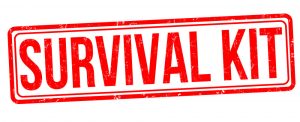
You may have already put your survival gear in your backpack or bought a ready-made bug-out bag, but our checklist will still be useful to you. You can compare lists and add something missing to your set. The reason for that is that we all have individual needs. Some might add more of the water purification tablets, others — a hand-crank radio to complete their emergency preparedness. But even if you have something that we did not mention in our list, this is rather a plus. You cannot overdo it in the matter of survival. Better to have more tools than to miss something during the emergency survival.
If you buy ready-made survival kits, our list will help you check if all the necessary items are present or worth adding something. In general, we recommend that you always add your own items because only you know your features, maybe you need additional medicines in the first aid kit, or you are a good fisherman and are sure that fishing tackle will help you feed in an emergency, or just put extra freeze-dried meals for any kinds of emergencies.
Create the complete bug-out bag using our checklist and your preferences.
Emergency Gear And Tools
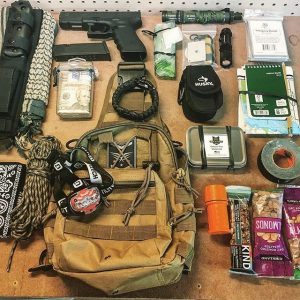
We have not arranged the list in any particular order of importance, but we have numbered it for your convenience. Make sure that all (or the majority) of the emergency supplies are present in your personal survival kit. Get survival glow sticks for the reason.
1. Survival Flashlight & An Extra Battery
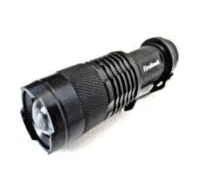
Your best bet is to get your survival flashlight with standard batteries, for example, where only one AA battery is required. Remember to pack one or more spare batteries for your flashlight.
A flashlight can be useful to you both in total blackout and simply in situations with short-period power outages. That is why having your survival ket prepared in advance standing in your house is smart — a power outage might happen any time, but you will already be prepared. For better or for worse, such phenomenon as a power outage is not considered to be a “natural disaster”, but it still might bring quite a lot of trouble and worsen your activities.
2. Dust Masks
Breathing is one of the basic necessities for every human being, and in a survival situation, dust masks or respirators may be needed to satisfy this need. This is the number one priority on a par with water pouches. Any disaster supplies kit must include dusk masks for all family members. Your emergency survival bag might lack an NOAA Weather radio or birth certificates, but never a respirator.
Emergencies can easily include fire and smoke like a California forest fire. These are true natural disasters that are rather difficult to resist. In this case, being prepared means not to “choke on the smoke”. Then a dust mask will come in handy.
Or as in the coronavirus pandemic, when we are all used to having a supply of respirators at home to protect the respiratory organs.
The masks are lightweight and do not take up much space so that you can buy them for future use. Or you can think of a more serious remedy and buy a full-blown gas mask. As we said, you can not overdo it when it comes to survival, and a respirator definitely belongs to the list of basic items to have in the bug-out bag.
3. Survival Knife
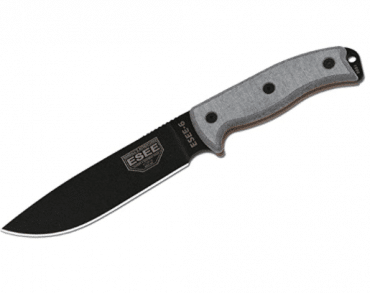
Despite the fact that we use knives in everyday life quite broadly, emergency preparedness does imply having a high-quality knife as well. A survival knife is exactly what you might need to cut your own food or woods for the fire.
But, we strongly recommend paying your attention to the multi-functional knife, also called a multi-tool. This multi-tool might be used in a variety of emergency survival situations. The best survival kits always include such tools for numerous purposes. Frequently such a tool includes a range of diverse instruments a person might need while surviving. Among them are
- A knife
- Can opener
- Bottles opener
- Pliers
- Scissors
- Screwdriver
- And many more instruments
Therefore, make sure to have a multi-purpose knife in your emergency kit. You can choose the ESEE knife, but it is rather bulky, so if you need to save space, you can also get a credit card knife. Make sure you have at least one in your kit.
4. Compact First Aid Kit
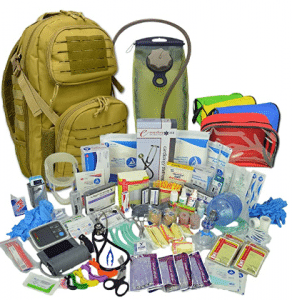
If you take too many First Aid supplies, you will run out of space for other equally important survival supplies.
Therefore, we advise you to buy a small First Aid Pack or assemble the first aid kit yourself. Hand-assembled kits are nothing worse than the bought ones. In a sense, hand-assembled options are even better: you can control for the exposure dates of the medicines and take only those you will need on a trip.
Just remember that the First Aid Kit must include abasic set of medical tools and medical supplies:
- alcohol swabs or wipes
- antibiotic ointment
- plasters
- clean gauze.
Put all your first aid supplies in one place (box or small medical bag). The best thing you can do is to make sure they all fit into one relatively small place like a glove box. If you have enough place, adding a hand sanitizer will also be a smart decision to make.
5. Emergency Whistles
Sometimes, emergency preparedness implies having quite unexpected things to be kept in your bug-out bags. At least, they might seem to be unexpected for the beginners in the world of surviving. One of such things is an emergency survival whistle.
You never know what kind of event is waiting for you while camping. It might happen that one or more family members will get lost, and there will be no way to connect to each other. Without such a whistle, this might last for several days — none of us want this to happen. That is why each customer when choosing the emergency survival gear must remember about the whistles. Those without moving parts are considered to be the most convenient and reliable.
Survival whistle takes up very little space but can be useful in several emergencies. You can rely on your voice, but any voice will never be louder than the whistle. A survival whistle will help drive away a wild animal or let your family know where you are.
We invite you to pay attention to the whistle from Survival Frog. They usually have excellent deals for loud and light whistles. This inexpensive device can save your life or make it easier, so be sure to put one in your emergency kit.
6. Emergency Light Sticks
The next kind of gear on the line is light sticks. When, for instance, your batteries are over, and a traditional flashlight cannot help you, these light sticks might appear to be quite handy. With these devices, you will save access to other family members and to all of the remaining supplies, including food. Looking for the appropriate instruments and foods in the dark is quite a complicated task, so, to stay prepared, keep the light sticks somewhere close to you.
Emergency lightsticks provide emergency hands-free lighting and can help first responders identify you. Emergency light sticks are inexpensive and easy to use and are a great tool to have in every preparedness kit.
7. Wilderness Survival Blanket
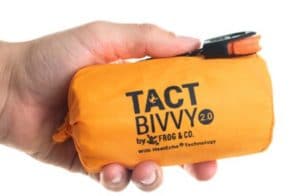
You should definitely have an item for an emergency shelter in your survival kit. This could be a sleeping bag, an emergency blanket, or something waterproof that keeps your body warm. Otherwise, your kit could not be considered a disaster supplies kit, because without this gear you will not be prepared completely.
We recommend purchasing bivy sacks. They are using the mylar technology that is used at NASA. Mylar is a thin material that is excellent at keeping out heat and providing shelter in bad weather.
Tact Bivvy takes up less space than sleeping bags but may even surpass some of them in quality.
Anyway, you should never underestimate sleeping bags and their necessity for emergency survival. If a natural disaster comes, these basic items will serve as a shelter and keep you alive.
8. Waterproof Lighter, Matches, and Striker
Fire is the means that has changed people’s lives. You can use fire to keep warm, cook food, attract attention, or drive away wild animals. Therefore, critical need to have a supply of waterproof matches, a survival lighter, and a Ferro rod in the emergency kit.
There are ways to kindle a fire without special devices, but why complicate an already difficult situation for yourself? Besides, you may not have time for this. That is why waterproof matches are your best choice. Without access to fire, you might lose access to food and boiled water as well. This is almost a catastrophic event, thus, matches that will not be destroyed by water have become basic necessities.
Luckily, matches are rather budget-friendly, that is why you can obtain quite a lot of those at one time. Do not forget to put a set of matches in waterproof packaging and a fire starter.
A fire starter kit is an absolute must for any survivalist.
9. FishLine And Hooks
No matter how much food you store, there will never be enough food, so we recommend putting something in your survival kit that will help you feed yourself and your family. The simplest method is fishing. It is less difficult than hunting.
Put the fishing kit in your bag or backpack. It is not necessary to take fashionable spinning rods and fishing rods that will take all the place. It is enough to store a strong line, hooks, and maybe bait to catch fish.
You can easily use a fishing line for keeping constant access to food, however, this is not the only way you can apply this device. In a sense, a fishing line is created from a strong and durable material, thus it will serve you for years if used and stored properly. For example, you can use it when creating a shelter — a strong wind might be rather destructive for the weak constructions; to strengthen one, you can apply the fishing line.
10. Biohazard Gear Bags
No one knows what emergency or natural disaster will come, and it is best to prepare for as many options as possible. So grab some Biohazard Bags. These garbage bags will not take up much space, and it is better to have them than to experience difficulties from their absence.
11. Emergency Poncho
Another must-have in survival kits that every survival shop customer should pay attention to. An emergency poncho keeps you dry and protects you from wind and cold weather. Better to buy several emergency ponchos so that they will be enough for all family members.
Emergency poncho will be an indispensable item if you stay outdoor without a roof over your head or if you need to get from one cover to another.
12. Compact Compass
We do not recommend relying too much on GPS equipment, anything can happen, and they can fail. Therefore, the less technology your emergency tools need, the better. This is why be sure to get the usual little compass for each of the emergency kits. Choose a simple, reliable compass that will point you in the right direction. There are times when people are very close to their destination, but they walk in circles because they cannot correctly orient themselves on the terrain, and if they had a compass, they would have coped and would have coped much faster.
You do not need an expensive fancy model, just a small compass that shows everything right.
13. Entertainment
Many people think that entertainment stuff will be superfluous and will only take place in the survival kit. But we will not agree.
Entertainment is something that will keep your mind healthy or distract you from the awful reality. Put a small card game, book, or magazine in your bug-out bag (in a pinch, you can burn them). But we think that distraction is handy not to go crazy, so it is better to get a deck of playing cards.
Getting a game for camping is a budget-friendly, however useful solution. Besides, you can use it not only when you are in some emergency situation, but also within the household. Games have a positive effect on human brains, especially those that make people think at least a little bit. When the world collapses, staying prepared is great, but staying at the same time in a good mood is priceless.
14. T-REX Duct Tape
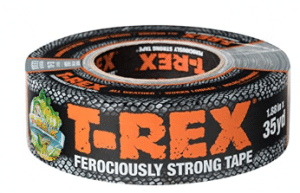
Duct tape made in the United States will allow you to fix or repair many things and will be indispensable in the event of a disaster.
T-Rex duct tape is one of those items that are difficult to replace with something, and the quality of the original item is much higher than analogs.
With such duct tape, you will be prepared for a range of situations, and it will not destroy your budget. Do not forget to obtain a couple of units for your next trip if you do not have those yet.
15. Nitrile Gloves
It may not occur to many people, but nitrile gloves must be on the emergency supplies list.
There are many situations in which they can be useful to you, for example:
- Clean the toilet or something you do not want to touch;
- Treat the wound;
- Touch contaminated areas or toxic materials;
- Touch something that gets you dirty.
Nitrile gloves will not weigh down your survival kit, but they can help in certain situations.
Emergency bags with such gloves are much more advance. There is an entire event range when you might need them, and if it turns out that none of your company members has the gloves, this will not only be a huge disappointment, but also a danger for the human life.
16. Personal Items
Experienced survivalists know how important it is to be dressed properly in survival circumstances. At this point, let us discuss shoes one has to wear when surviving outside.
The first thing you have to keep in mind is that it does not really matter how your boots look like. When it comes to surviving in horrible conditions, with snow or strong wind, your shoes must serve you as your main helper (after your mind). Of course, no customer will put one’s shoes into the kit — obviously, they are supposed to be on the survivalists, not in their bags — but since we are talking about essentials in critical situations, let us briefly cover shoes as well.
Choosing shoes for camping, do not think about fashion. Fashion will not help you in case of an emergency. Fashionable but uncomfortable shoes are more likely to kill you. That is why when picking pairs for yourself and your family, try them on at first and try to imitate walking. Even a little hint that they are uncomfortable claims that you should try something else.
Next, unfortunately, not all really comfortable shoes might work for camping. You do not know what kind of situation might occur, frequently surviving implies such unpredictable and rather unpleasant events like chemical spills on the ground or too slippery surfaces. In these cases, no matter what you have in your kits — these items will not be that useful without proper shoes.
In other words, look for a pair, capable of resisting oil, soil salts, chemical spills, and other damaging substances that might destroy your ordinary shoes.
17. Personal Items
Everything we listed above is included in the emergency kits checklist for all people. Now you need to think about which items will be more difficult for your family to survive without.
If you have a car, we recommend putting spare car keys in the car survival kit. We strongly advise you to create a special car survival kit that will be kept in a car. When choosing a bag for a car, you might consider getting larger kits, that can be stored in a trunk.
If you have a small kid, then you definitely need to think about baby supplies. If a kid is not too small, you can create a separate survival kit for him. You can put here things that are light in weight, like toilet paper, NOAA weather radio, or an additional set of batteries. With a personal bug-out bag, your child will feel like a full member of the team, and this is helpful to grow him up as a responsible person.
Women will want to take the personal hygiene items or hygiene kit they need. You might also need toilet paper if you are planning to stay outside for long time periods.
Perhaps you are taking any medications regularly, then be sure to put them in the first aid kit.
You need to think, about which items you cannot survive for several days without, and put them in your disaster kit.
Besides everything mentioned above, you might need to take some important documents as well. Usually, this implies some insurance policies (insurance policies are essential if your health is damaged and you need professional help), passports, proof of address, and other documents.
Emergency Water And Food
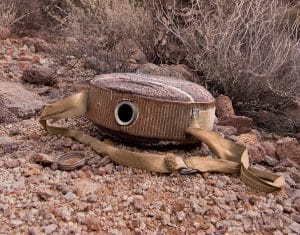
All of the survival gear listed above are aids in your survival path, but the first necessities of an emergency preparedness kit will be food and drinking water storage.
We will be guided by the Red Cross’s advice on that matter. They advise having a minimum of:
Food — non-perishable foods (2-week supply for home, 3-day supply for evacuation);
Water — one gallon per person a day (2-week supply for the home kit, 3-day supply for evacuation kits).
Water
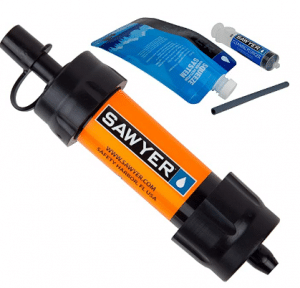
In addition to supplying emergency drinking water, you need to stock up on water purification tablets and water filters. Water purification tablets are light in weight and do not occupy much space in the emergency kit. A person might survive several days without drinking water, but this is an extreme situation, which is inadvisable. Traditional kits should include water pouches because permanent access to water is indeed essential.
People need water daily for a million things, from drinking and preparing food to washing the house and clothes.
You might keep water in the bottles or obtain special water pouches for emergencies. Remember that your house is your shelter, and if a natural disaster comes, you might not be able to leave it for several days or even for several weeks. So, make sure you have enough water bottles for yourself and for your relatives.
Be sure to take not only bottled water but also a means for water purification and filtration.
Put in your survival kits, water purification tablets, and a small water filter like the Sawyer Mini.
Remember that if you have devices to purify the water, you will not be deprived of drinking water at all.
Food
Choose foods that are high in calories and protein, but avoid chocolates and sweets as they will only give you a short-term boost due to their high sugar content.
Freeze-dried meals, packets of trail mix, or peanuts are good options for an emergency snack.
Another good option is to stock up on some pemmican for your survival disaster kit. Pemmican is a high-protein meat bar with an extremely long shelf life that you can prepare yourself at home or buy. Their main advantages:
- the ability to store without a refrigerator up to 50 years
- ease of use
- high calories and protein
- a variety of options.
Now, let us discuss emergency food in detail. All survival kits must be “equipped” with something to eat because food is the main source of human energy. Without food, you will not be able to overcome the obstacles of surviving. You might withstand hunger for several days, but then your power will be going away quickly and dramatically. We should not let it happen, that is why we should take care of the food inside your shelter in advance.
At this point, let us consider what you might take to the trip (not keep at home). A great option would be an MRE — meal ready to eat. Usually, it contains the following:
- The main meal (say, meat and rice, or other options, there are multiple on the American market)
- Side meal
- Crackers and desserts
- Beverage (various, like coffee)
- Utensils
- Flameless ration heater (this is essential to heat the meal so that is was eatable and tasty)
- Chewing gum
- Matches and toilet paper
As you see, a traditional MRE also includes some hygiene items — if you run out of yours, you can use those suggested by the package.
For emergency kits, MRE’s are great options, because they are easy to pack one on another, and they are not heavy. They are also applicable for home storage if you are thinking about preparing your house emergency stock.
Another option to consider is vacuum-sealed foods. You can either buy them and keep at your shelter or make them on your own. However, for such an initiative, you will need a vacuum sealer, and this is a machine that costs money. Luckily, there are not too expensive options on the market — each customer will find a perfect sealer for themselves.
If you have a vacuum sealer at home, you can vacuum seal food by yourself. This food can be stored much longer than food kept in traditional ordinary conditions. You can seal various kinds of food, starting from pasta and finishing with fruit and vegetables. But, concerning the latter point, make sure that your fruit and vegetables are not too juicy — this might destroy the vacuum sealer effect.
The last but not the least point on this improvised list is freeze-dried food. Freeze-dried meals might survive a 25-years shelf-life — a perfect option in the long-term perspective. There is a wide range of foods that you can freeze dry without doubting. You can process different meat kinds, be it chicken or fish, vegetables and fruits, coffee and even eggs! The idea behind freeze-drying is simple: you freeze the product, the machine removes moisture from it, and then it is packed in a vacuum package.
On a part with water in bottles, these foods will be eatable almost forever!
Do not neglect supplies of non-perishable food. This will give you the strength to overcome disasters.
Final Word
We have listed the essential items that should be found in every survival kit. If space and size allow you, we recommend that you also add a hand-crank radio, hand sanitizer, plastic sheeting, window breaker, sewing kit, or a few other small items to the list that can help you and your family in survival.
Yes, survival kits are similar in targets with bug-out bags, but no one forbids you to have both. It is better when consumables are available in several copies. Do not worry if something is duplicated. This is not in vain, and the better you will be prepared for any disaster.
FAQ
What are the items in a survival kit?
The most important and useful survival supplies and tools are contained in the survival kits. First of all, always include water, devices for purification, non-perishable food, and first aid kits. Next, you should collect tools such as a knife, flashlight, matches and lighter, compass, duct tape, fish line and hooks, light sticks, whistle, dust masks. Do not forget the survival blankets, emergency waterproof poncho, nitrile gloves if the space of your kit permits, also take some entertainment stuff.
What are the top 10 survival items?
First of all, you need to think about the human basic needs and purchase items that satisfy them.
The list of absolutely undeniable supplies you will need in case of a disaster:
- water and water filters/tablets
- food
- dust masks
- survival blanket or sleeping bag
- waterproof matches and lighter
- first aid kit.
This is an absolute must-have. We would put the next 4 items in a disaster kit: a compass, survival knife, flashlight, and an emergency whistle.
What is the best survival kit?
The best survival kit necessarily includes all the tools and other survival stuff from our list. But even if you buy survival kits that have all of these items, be sure to add personal items, for example, some special family first aid kit constituents or contact lenses. The best survival kit is a customized kit that will help satisfy the basic needs and specific individual ones, too.
What should be in a 72-hour emergency kit?
The basic three-day emergency kit packaging guidelines include basically everything we talk about in the article. Water (one gallon for one person, per day), food, hand-crank radio, solar cell phone charger, first aid kit, flashlight, duct tape, whistle, local map, trash bags, and wet wipes, pliers, window breaker. This is the most basic shortlist of the essentials for your kit. If you want to be well-stocked, it needs to be expanded.
How much does the survival kit cost?
The cost of a survival kit depends on what is present inside of it. A high-quality disaster supplies kit might cost even a thousand dollars — quite a large sum that might damage one’s budget. But, when it comes to human lives, you should not save money. A good and reliable survival kit will cost you approximately 400$. Such bug-out bags might serve you for an extended period of time if kept properly.

